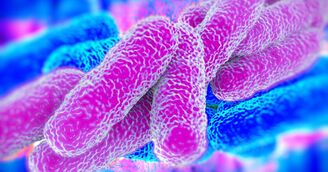"Legionella pneumophila" examined by the SGGW scientists
SGGW scientists together with scientists from the University of Texas Southwestern Medical Center, Dallas, USA, have identified an interesting biochemical mechanism of one of the Legionella pneumophila bacterial effector proteins. The discovery was described in the Science journal. Will it contribute to the invention of a cure for legionellosis and it will no longer be an incurable disease?
Legionellosis is a bacterial respiratory infection caused by one of the family Legionellaceae. The results of the research were described in the Science journal, in the article titled The results of the work were described in the journal Science in the article Bacterial pseudokinase catalyzes protein polyglutamylation to inhibit the SidE-family ubiquitin ligases. The authors were dr Vincent Tagliabracci, and Miles Black, University of Texas Southwestern Medical Center, Dallas, USA, and dr hab. Krzysztof Pawłowski and dr Marcin Gradowski, representing Institute of Biology, SGGW.
Legionella pneumophila
Legionella bacteria can be found in natural freshwater environments, usually in insufficient numbers to cause disease. Legionella grows best in warm water, as in hot tubs, cooling towers, hot water tanks, large plumbing systems, or the air-conditioning systems of large buildings. The disease is contracted by inhalation of contaminated mist or vapor, mainly through aerosolization of infected water in air-conditioning systems, hot-water systems, humidifiers, nebulizers, showers and spa pools. Outbreaks have mostly been linked to aerosol sources in the community, cruise ships and hotels, with the most likely sources being whirlpool spas, air-conditioning units in large buildings, potable (drinking) water systems, and water used for bathing. The term Legionnaire’s disease was coined as a result of an outbreak of the previously unrecognized respiratory disease in an American Legion meeting in Philadelphia in 1976, but it is now recognized worldwide, with many infections being contracted during travel abroad, particularly to Spain, Turkey and some other Mediterranean areas. Unfortunately, it is antibiotic-resistant bacteria, capable of causing serious diseases, including incurable ones.
Legionella pneumophila is an accidental pathogen that replicates intracellularly in macrophages, says Gradowski. The effectors interfere in various host cellular processes, such as cytoskeleton rearrangement, signaling, cellular adherence, transcription, vesicular trafficking, membrane biogenesis, apoptosis and metabolism. They can affect a given process directly or indirectly cause some effect. Some effector proteins are enzymes, such as kinases, proteases, phosphatases, glycosylases, acetylases or lipases, etc. Others mimic functions of host proteins, yet others are transcription factors or protein–protein interaction partners.
Bacterial effector SidJ
Marcin Gradowski searched for protein kinases in Legionella pneumophila – enzymes that bind a phosphate group (parts of ATP – adenosine triphosphate) to another protein. Such a bond usually leads to a change in the biological activity of another protein, the ability to bind to it, or to move the molecule within the cell. And such a kinase has been found! I use custom approaches and non-standard bioinformatics tools which, together with my knowledge of a given topic, allow me to see the evolutionary similarity of proteins at the detection limit. This allows me to find new protein families, which makes my work unique. One of the Legionella proteins turned out to be a protein with very distant similarity to a kinase, he explains. We decided with my supervisor, dr hab. Krzysztof Pawłowski we will share our discovery with our colleagues, the research group led by Dr. Vincent Tagliabracci. Studies have shown that the observed kinase binds the ATP molecule (similarly to kinases), but then attaches the AMP (adenosine monophosphate) to the protein instead of phosphate.
When the Legionella pneumophila bacterium infects the human host, it releases its effectors (including the SidJ and SidE proteins) that help it survive and reprogram host cells: It should be noted that SidE is a family of bacterial effector proteins - ubiquitin ligases. The addition of ubiquitin to a substrate protein is called ubiquitylation. Ubiquitination is a tightly regulated, highly specific, and ATP-dependent biological process carried out by a complex cascade of enzymes.
Eukaryotic ubiquitin system does not appear in bacteria, there is another process; a special bridge is formed between the ubiquitinated protein and ubiquitin, which eukaryotic enzymes (deubiquitinases, having an antagonistic effect on ubiquitinases) are unable to break. Eukaryotic ubiquitinases target proteins to be degraded including bacterial effectors. The bacterium does not want to be degraded, so it ubiquitates (bacterially) eukaryotic proteins and interferes with this process. Moreover, it reduces the amount of free ubiquitin in the host cell (attaching it to water molecules). This protects effectors. Bacterial ubiquitination is a toxic process for an infected cell. If left unchecked, it would lead to the death of the host cell by disabling most of its proteins and thus the processes of the cell. After all, the bacterium wants to survive by benefiting from the host. And there is a way to do it – SidJ protein. SidJ regulates the action of SidE ligases by blocking their activity. SidJ works only within the infected cell due to the fact that it binds a protein found only in eukaryotes - calmodulin. SidJ is activated by host cell calmodulin to polyglutamylated the SidE-family of ubiquitin (Ub) ligases. That is how the bacteria "protect" itself from its activities.
End of legionellosis?
The discovered mechanism of the SidJ effector protein, which regulates (blocks) another bacterial effector protein, SidE, gives hope for finding a cure for the incurable disease - Legionellosis disease. The use of blocking SidE proteins is a great idea because in response to this action, bacterial proteins will be degraded and the bacteria will not be able to reproduce in the host cells. If we could create a specific protein (artificial blocker) for SidE that acts like SidJ, we would be able to stop the infection process. Or even apply SidJ artificially, immediately after detecting the infection, summarizes Marek Gradowski.
Prepared by: Anita Kruk
Expert consultant: dr Marek Gradowski, Institute of Biology, SGGW




